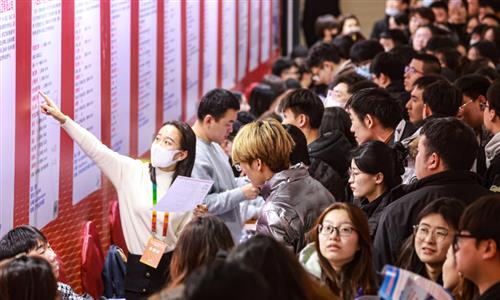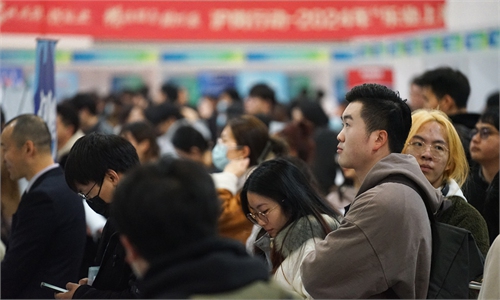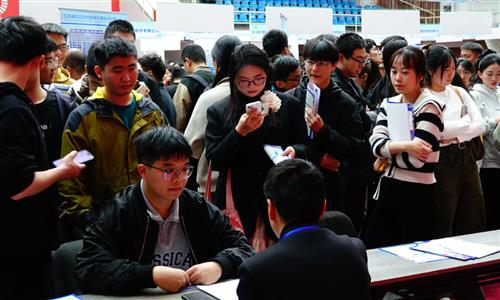
People attend a job fair targeted at the Guangdong-Hong Kong-Macao Greater Bay Area held at the Shenzhen World Exhibition & Convention Center in South China's Guangdong Province on November 22, 2023. Some 1,200 companies participated in the fair, offering nearly 50,000 positions. Photo: VCG
China's youth unemployment rate reached 15.3 percent in February, rising 0.7 percentage points month-on-month, the National Bureau of Statistics (NBS) said on Wednesday.
Analysts said that the rate is expected to ease in the coming months as more companies step up hiring amid the economic recovery and policy support.
The jobless rate of those aged 25 to 29 (excluding students) was 6.4 percent in February, while the rate for those aged 30 to 59 was 4.2 percent.
Although the youth unemployment rate was relatively high, it still fell from more than 20 percent a year earlier, underscoring a sound trend in the job market, Li Changan, a professor at the Academy of China Open Economy Studies of the University of International Business and Economics, told the Global Times.
As the number of young job-seekers keeps rising, the authorities should increase the supply of jobs, Li said. Developing new quality productive forces and upgrading traditional industries with artificial intelligence and big data will work in this regard, Li said.
"The youth unemployment rate is expected to ease in the coming quarters," Li said. New data showed that the macro economy continues to recover, and accordingly, hiring demand will keep increasing, he said.
Starting from December, the NBS resumed reporting youth unemployment rates after a suspension, when the agency adjusted its modeling and statistical methodology to better reflects the employment situation.
China's employment remained basically stable in the first two months of 2024, with the surveyed urban unemployment rate averaging 5.3 percent, official data showed on Monday.
Favorable factors for stabilizing the job market continue to accumulate, Liu Aihua, a spokesperson of the NBS, said at a press conference on Monday.
Along with the sustained recovery of the Chinese macroeconomy, especially the services sector, and the accelerated transition of new and old sources of growth momentum, new industries including the digital, green and silver economies will continue to support urban employment, Liu said.
According to a report that Chinese job-hunting platform Zhilian Zhaopin sent to the Global Times on Monday, the continuous release of hiring demand in the four weeks following the Spring Festival holidays is steadily warming up the job market.
Small and micro-sized companies in the March 11-15 week posted an increase in hiring of 4 percent from the previous week. These firms - with fewer than 100 employees - were the fastest-growing market entities in the period, the report showed.
Over the period, services and consumption, high-end manufacturing and new energy were the three fields that provided the most jobs, it said.
However, the pressure on aggregate job creation is likely to linger, with structural issues becoming more pronounced, as China is expected to see more than 11.7 million college graduates in 2024, and the number of young job-seekers continues to grow.
Government agencies and provinces have stepped up efforts to stabilize and expand employment with multiple measures in order to ensure high-quality employment for fresh graduates.
For example, Northwest China's Xinjiang Uygur Autonomous Region plans to hold a large-scale job fair on March 23, aiming to provide more than 18,000 jobs for college graduates.



